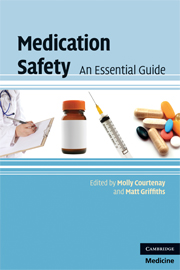Book contents
- Frontmatter
- Contents
- List of contributors
- Preface
- 1 Introduction to medication errors and medication safety
- 2 Safety in prescribing
- 3 Safety in dispensing
- 4 Safety in administering
- 5 Adverse drug reactions and drug interactions
- 6 Interface of care and communication
- 7 Parenteral drug administration
- 8 Calculations
- 9 Controlled drugs and patient safety
- 10 Reporting medication errors and near misses
- 11 Ensuring safety through evidence-based medicine
- Index
- References
1 - Introduction to medication errors and medication safety
Published online by Cambridge University Press: 22 January 2010
- Frontmatter
- Contents
- List of contributors
- Preface
- 1 Introduction to medication errors and medication safety
- 2 Safety in prescribing
- 3 Safety in dispensing
- 4 Safety in administering
- 5 Adverse drug reactions and drug interactions
- 6 Interface of care and communication
- 7 Parenteral drug administration
- 8 Calculations
- 9 Controlled drugs and patient safety
- 10 Reporting medication errors and near misses
- 11 Ensuring safety through evidence-based medicine
- Index
- References
Summary
A medication safety incident is defined by the National Patient Safety Agency (NPSA) as:
‘any unintended or unexpected incident which could have or did lead to harm for one or more patients’ (NPSA, 2007:9).
These incidents can occur at each stage of the process involved in the delivery of medicines to patients, i.e. prescribing (including transcribing or physician ordering), dispensing, preparation, administering and monitoring (NPSA, 2007). Medication incidents have been reported as accounting for 10%–20% of all Adverse Events (AE) (Department of Health (DoH), 2004), i.e. an event that causes an unintended injury to a patient that either prolongs hospitalization or produces disability (Karson & Bates, 1999).
The impact of medication safety incidents on patient outcomes includes increased length of stay, disability and mortality (Vincent et al., 2001). Across the UK, about two and a half million medicines are prescribed across hospitals and the community every day (DoH, 2004) and an indicator of quality, adopted to demonstrate medication safety, is the incidence of medication errors (DoH, 2004). The Government has committed to reducing the incidents of medication errors in prescribed drugs by 40% (DoH, 2004).
Between January 2005 and June 2006, 60 000 medication incidents were reported to the NPSA via the National Reporting and Learning System (NRLS) (NPSA, 2007). Although most medicine-related activity is carried out in the community, over 80% of the incidents reported to the NPSA were from the hospital setting. The majority of these incidents (over 80%) did not result in harm.
- Type
- Chapter
- Information
- Medication SafetyAn Essential Guide, pp. 1 - 6Publisher: Cambridge University PressPrint publication year: 2009



